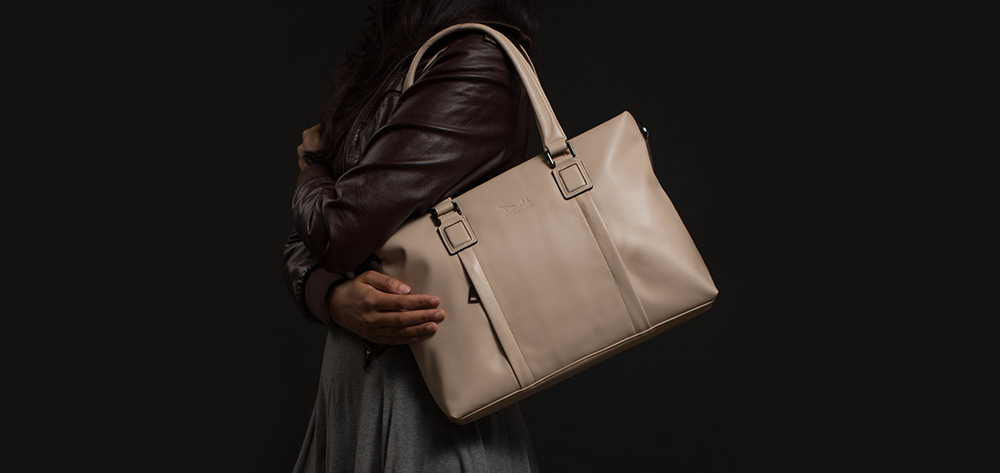So, you’ve just oogled over the designs at New York Fashion Week, and are now in the mood to splurge on the latest trends. If leather and suede bags are your thing, but supporting the leather industry totally isn’t, worry not, as there is a whole gorgeously sustainable market with vegan alternatives to animal-derived materials. As described by Paras Doshi of US fashion retailer, Doshi, vegan leather bags are “clean on the outside, clean on the inside.”
We were lucky enough to get our hands on their Saddle Bag (which is available for pre order now!). Knowing traditional leather, and not necessarily having much experience with quality vegan leather, we were pleasantly surprised with what we found. The Saddle Bag has a sleek matte finish with a very convincing suede-like fold and, much like the real-deal, is firm yet durable.
But perhaps, like us, you’ve got a whole satchel of questions about vegan leather. What is it?
We caught up with Doshi for an insider’s scoop just in time for the launch of their fall handbag line. So turn hippy into hip, strut your stylish stuff and brace yourself for the very best of ethical fashion.

A Guide To The Stylish World Of Vegan Leather – With Doshi
Manufacturing
Q: ‘How is vegan leather made and is it sustainable?’
“There are several types of vegan leather. The most common is a synthetic leather that is made by taking a polyester or microfiber backing and bonding a layer of polyurethane (PU) on it. The PU can be made to have any grain desired. In my view, sustainability is a function of several factors including the amount of resources used to make a product and the effect of using those resources, the longevity of the product, and how readily a product breaks down once it has been used.”
Q: ‘Production is small compared to traditional leather so how will it scale up?’
“Vegan leather” is actually easily available. It just depends on whether you’re looking for a low quality, cheap alternative to leather or a real, full-fledged honest to goodness vegan leather. If you’re looking for the former, it’s available in spades – but it may peel, crack, not breathe, etc. . If you’re looking for the latter, scaling up vegan leather production is just a function of demand. Microfiber PU is already an awesome material that is often technically better than animal leather. Manufacturing capability is already in place. Demand will drive variety, further technological advances in the material, etc.”
Environment

Q: ‘What are the environmental impacts of traditional leather vs that of vegan leather?’
“Very generally speaking, vegan leather is very likely to have less environmental impact than animal leather. Please see my article on vegan leather for a more in depth explanation.
People often comment on the petroleum footprint of vegan leather but petroleum/plastics are used in SO many parts of society, we’re being unreasonably critical if we just focus on them in this application. The world does need to use less plastic in general.”
Sensory
 Q: ‘Smell, touch and feel – sounds weird but a lot of people like the smell of leather and if we really want to replace it should we be replicating that?’
Q: ‘Smell, touch and feel – sounds weird but a lot of people like the smell of leather and if we really want to replace it should we be replicating that?’
“You’re not just smelling animal skin when you’re smelling animal leather. It’s a combo of the skin, chemicals, and tanning process. Replicating smell is a matter of using certain chemicals. It’s like the new car smell people like. While it’s possible to replicate the odors, I would be more concerned about the manufacturing process using chemicals that are eco/health friendly and which are not releasing gases or odors (however familiar or attractive they may be). One factor factories use to gauge quality if whether a product smells less and whether odors dissipate quickly.”
Chemicals

Q: ‘Tanneries use a lot of water and nasty chemicals but what goes into vegan leather?’
“This is a question that has a very wide range. Vegan leathers can also use water and nasty chemicals but they don’t have to. There’s a range and I don’t know about the level of water and chemicals used for each type when compared to leather. It’s generally accepted (again refer to my piece on leather) that considering all of the stages animal skin goes through to become leather, it is far more water/resource/chemical/energy intensive than synthetic leather. With animal leather, there are many steps which involve chemicals whereas in making synthetic leather, you take the backing (polyester, microfiber, etc.) and adhere polyurethane to it. It’s a much simpler process.
The higher end vegan leather factories are eco-friendly and are engaging in practices to minimize chemical use, energy use and water usage.”
Appeal

Q: ‘Which big brands are using vegan leather and how will it become mainstream or rival traditional leather?’
“There aren’t really any big brands that use vegan leather consistently unless they’re using it as a replacement; using a cheap form of synthetic leather that is a cost guided decision. How do we make is more mainstream? Buy Doshi! Ha! It’s really a matter of demand. Just like organizations spreading information about the downsides of consuming animal products, we need to show people the downsides of the animal leather industry – from the effects on workers, the environment, and of course animals.”
The Future

Q: ‘Doshi – what makes you stand out and what can we expect to see in your future and the future of leather?’


